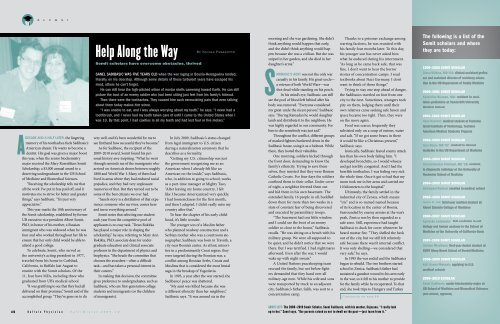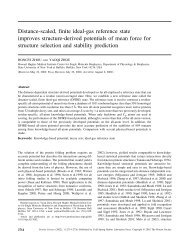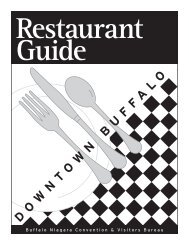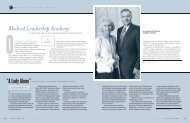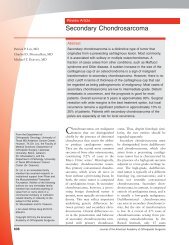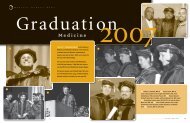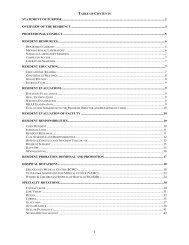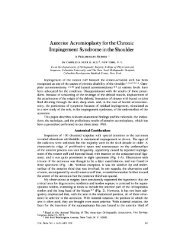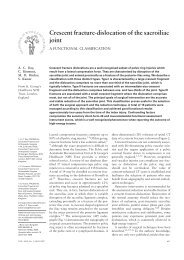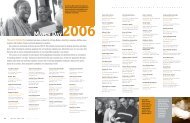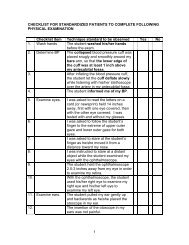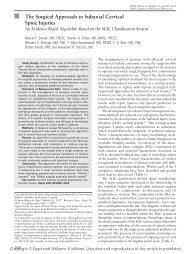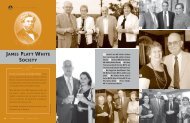White society James Platt
White society James Platt
White society James Platt
Create successful ePaper yourself
Turn your PDF publications into a flip-book with our unique Google optimized e-Paper software.
A l u m n i<br />
ADECADE AND A HALF LATER, the lingering<br />
memory of his toothaches fuels Sadibasic’s<br />
American dream: He wants to become a<br />
dentist. His goal was given a major boost<br />
this year, when the senior biochemistry<br />
major received the Mary Rosenblum Somit<br />
Scholarship, a $3,000 annual award to a<br />
deserving undergraduate in the UB School<br />
of Medicine and Biomedical Sciences.<br />
“Receiving the scholarship tells me that<br />
all the work I’ve put in has paid off, and it<br />
motivates me to strive for better and greater<br />
things,” says Sadibasic. “I’m just very<br />
appreciative.”<br />
This year marks the 10th anniversary of<br />
the Somit scholarship, established by former<br />
UB executive vice president Albert Somit,<br />
PhD, in honor of his mother, a Russian<br />
immigrant who was widowed when he was<br />
four and who worked throughout her life to<br />
ensure that her only child would be able to<br />
attend a good college.<br />
To celebrate, Somit, who served as<br />
the university’s acting president in 1977,<br />
traveled from his home in Carlsbad,<br />
California, to Buffalo last August to<br />
reunite with the Somit scholars. Of the<br />
11, four have MDs, including three who<br />
graduated from UB’s medical school.<br />
“It was gratifying to see that they had all<br />
delivered on their promises,” Somit said of the<br />
accomplished group. “They’ve gone on to do<br />
Help Along the Way<br />
Somit scholars have overcome obstacles, thrived<br />
SANEL SADIBASIC WAS FIVE YEARS OLD when the war raging in Bosnia-Herzegovina landed,<br />
literally, on his doorstep. Although some details of those turbulent years have escaped his<br />
mind, others he can’t forget.<br />
He can still hear the high-pitched whine of mortar shells careening toward Earth. He can still<br />
picture the boot of an enemy soldier who had been sitting just feet from his family’s hideout.<br />
Then there were the toothaches. They caused him such excruciating pain that even talking<br />
about them today makes him wince.<br />
“I was unable to eat, and I was always worrying about my teeth,” he says. “I never had a<br />
toothbrush, and I never had my teeth taken care of until I came to the United States when I<br />
was 10. By that point, I had cavities in all my teeth and had lost four or five molars.”<br />
very well, and it’s been wonderful for me to<br />
see firsthand how successful they’ve become.”<br />
As for Sadibasic, the recipient of the<br />
2009–2010 award, Somit found his personal<br />
history awe-inspiring. “What he went<br />
through reminds me of the immigrants who<br />
arrived on America’s shores between roughly<br />
1880 and World War I. Many of them had<br />
lived in areas where they had endured racial<br />
prejudice, and they had very unpleasant<br />
memories of that. But they turned out to be<br />
some of the best citizens we ever had.<br />
“Sanel’s story is a distillation of that experience:<br />
someone who survives, comes here<br />
and turns everything around.”<br />
Somit notes that selecting one student<br />
each year from the competitive pool of<br />
applicants is no easy task. “Dean Rokitka<br />
has played a major role in shaping the<br />
scholarship,” he says, referring to Mary Ann<br />
Rokikta, PhD, associate dean for undergraduate<br />
education and clinical associate<br />
professor in the department of physics and<br />
biophysics. “She heads the committee that<br />
chooses the awardees—often a difficult<br />
task—and has taken a personal interest in<br />
their careers.”<br />
In making that decision, the committee<br />
gives preference to undergraduates, such as<br />
Sadibasic, who are first-generation college<br />
students and immigrants (or the children<br />
of immigrants).<br />
By Nicole Peradotto<br />
In July 2009, Sadibasic’s status changed<br />
from legal immigrant to U.S. citizen<br />
during a naturalization ceremony that he<br />
describes as a formality.<br />
“Getting my U.S. citizenship was just<br />
the government recognizing me as an<br />
American when I already felt like an<br />
American on the inside,” says Sadibasic,<br />
who, in addition to going to school, works<br />
as a part-time manager at Mighty Taco.<br />
“After leaving my home country, I felt<br />
like I became Americanized very quickly.<br />
I had homesickness for the first month,<br />
and then I adapted. I didn’t really miss my<br />
country after that.”<br />
To hear the chapter of his early childhood,<br />
it’s little wonder.<br />
The younger son of a Muslim father<br />
who planned roadway construction and a<br />
Serbian mother who was a courtroom stenographer,<br />
Sadibasic was born in Travnik, a<br />
city near Bosnia’s center. As ethnic minorities<br />
in a predominantly Croat region, they<br />
were targeted during the Bosnian war, a<br />
conflict among Bosnian Serbs, Croats and<br />
Muslims that is considered the most brutal<br />
saga in the breakup of Yugoslavia.<br />
In 1993, a year after the war started, the<br />
Sadibasics’ peace was shattered.<br />
“My aunt was killed because she was<br />
a different ethnicity than her neighbors,”<br />
Sadibasic says. “It was around six in the<br />
morning and she was gardening. She didn’t<br />
think anything would happen that early,<br />
and she didn’t think anything would happen<br />
because she was a civilian. But she was<br />
sniped in her garden, and she died in her<br />
daughter’s arms.”<br />
S<br />
ADIBASIC’S AUNT was not the only war<br />
casualty in his family. His great-uncle—<br />
a veteran of both World Wars—was<br />
shot dead while standing on his porch.<br />
In his mind’s eye, Sadibasic can still<br />
see the pool of blood left behind after his<br />
body was removed. “Everyone considered<br />
my great-uncle the nicest person,” Sadibasic<br />
says. “During Ramadan he would slaughter<br />
lamb and distribute it to the neighbors. He<br />
was highly regarded in our community. For<br />
him to die senselessly was just sad.”<br />
Throughout the conflict, different groups<br />
of masked fighters hunkered down in the<br />
Sadibasic house, using it as a hideout. While<br />
there, they looted their valuables.<br />
One morning, soldiers kicked through<br />
the front door, demanding to know the<br />
family’s ethnicity. Trying to save themselves,<br />
they insisted that they were Roman<br />
Catholic Croats. For four days the soldiers<br />
confined them to their cellar. Under cover<br />
of night, a neighbor ferreted them out<br />
and hid them in his own basement. The<br />
extended family, 16 people in all, huddled<br />
down there for more than two weeks in a<br />
state of constant fear of being discovered<br />
and executed by paramilitary troops.<br />
“The basement had one little window,<br />
and I could see the boot of an enemy<br />
soldier so close to the house,” Sadibasic<br />
recalls. “He was sitting on a bench with his<br />
military group. We were all supposed to<br />
be quiet, and he didn’t notice that we were<br />
there. But I was terrified. I had nightmares<br />
afterward. Even after the war, I would<br />
wake up with night sweats.”<br />
A United Nations peacekeeping team<br />
rescued the family, but not before fighters<br />
demanded that they hand over all<br />
military-age men. While his wife and sons<br />
were transported by truck to an adjacent<br />
city, Sadibasic’s father, Salih, was sent to a<br />
concentration camp.<br />
Thanks to a prisoner exchange among<br />
warring factions, he was reunited with<br />
his family four months later. To this day,<br />
his younger son has never asked him<br />
what he endured during his internment.<br />
“As long as he came back safe, that was<br />
fine. I don’t want to hear the horror<br />
stories of concentration camps. I read<br />
textbooks about Nazi Germany. I don’t<br />
want to think of those things.”<br />
Trying to stay one step ahead of danger,<br />
the Sadibasics traveled on foot from one<br />
city to the next. Sometimes, strangers took<br />
pity on them, lodging them until their<br />
own relatives came seeking safe haven and<br />
space became too tight. Then, they were<br />
on the move again.<br />
Food was scarce; frequently they<br />
subsisted only on a soup of onions, water<br />
and salt. “If we got some beans in there<br />
it would be like a Christmas present,”<br />
Sadibasic says.<br />
Ironically, Sadibasic feared enemy attack<br />
less than his own body failing him. “I<br />
developed bronchitis, so I would wheeze<br />
and get terribly congested. And I had the<br />
horrible toothaches. I was feeling very sick<br />
the whole time. Once it got so bad that my<br />
mom took me in her arms and carried me<br />
10 kilometers to the hospital.”<br />
Ultimately, the family settled in the<br />
industrial city of Zenica, which means<br />
“iris” and is so-named named because<br />
of its location in the center of Bosnia.<br />
Surrounded by enemy armies at the war’s<br />
peak, Zenica was by then regarded as a<br />
safe zone. Still, experience had taught<br />
Sadibasic to duck for cover whenever he<br />
heard mortar fire. “They shelled the heck<br />
out of the city, but we still felt relatively<br />
safe because there wasn’t internal conflict.<br />
It was only shelling—we considered that<br />
very safe,” he says.<br />
In 1995 the war ended and the Sadibasics<br />
began to rebuild. The two brothers started<br />
school in Zenica. Sadibasic’s father had<br />
sustained a gunshot wound to his arm early<br />
in the war, so it fell to his mother to provide<br />
for the family while he recuperated. To that<br />
end, she took trips to Hungary and Turkey<br />
Continued on page 46<br />
The following is a list of the<br />
Somit scholars and where<br />
they are today:<br />
1999–2000 SOMIT SCHOLAR<br />
Diana Wilkins, MD ’04: clinical assistant professor<br />
and assistant director of residency educa-<br />
tion in the UB Department of Family Medicine<br />
2000–2001 SOMIT SCHOLAR<br />
Katherine Rizzone, MD: resident in med-<br />
icine–pediatrics at Vanderbilt University<br />
Medical School<br />
2001–2002 SOMIT SCHOLAR<br />
Ilana Kuznets: medical student at Technion<br />
Israel Institute of Technology, Technion<br />
American Medical Students Program<br />
2002–2003 SOMIT SCHOLAR<br />
Inna Rozov, MD ’07: resident in internal<br />
medicine in the UB Department of Medicine<br />
2003–2004 SOMIT SCHOLAR<br />
Narasimhachar Prativadi, MD ’08: resident<br />
in diagnostic radiology at the University of<br />
Rochester School of Medicine<br />
2004–2005 SOMIT SCHOLAR<br />
Abdulqwai Rashed: enrolled in medical school<br />
2005–2006 SOMIT SCHOLAR<br />
<strong>James</strong> B. Lim: third-year medical student at<br />
Albert Einstein College of Medicine<br />
2006–2007 SOMIT SCHOLAR<br />
Agnieska Laskowski: PhD candidate in cell<br />
biology and human anatomy in the School of<br />
Medicine at the University of California-Davis<br />
2007–2008 SOMIT SCHOLAR<br />
Comlan Missihoun: first-year dental student at<br />
SUNY Stony Brook School of Dental Medicine<br />
2008–2009 SOMIT SCHOLAR<br />
Kofi Aseno-Mensah: applying to U.S.<br />
medical schools<br />
2009–2010 SCHOLAR<br />
Sanel Sadibasic: senior biochemistry major at<br />
UB School of Medicine and Biomedical Sciences<br />
(see article, opposite)<br />
4 6 B u f f a l o P h y s i c i a n F a l l / W i n t e r 2 0 0 9 – 1 0<br />
ABOVE LEFT: The 2009–2010 Somit Scholar, Sanel Sadibasic, with his mother, Snjezana. “I really look<br />
up to her,” Sanel says. “Our parents raised us not to dwell on the past—just learn from F it.” a l l / W i n St ep r i 2n 0g 0 29 0– 01 40<br />
B u f f a l o P h y s i c i a n<br />
4 7


